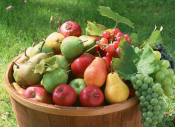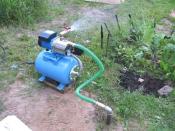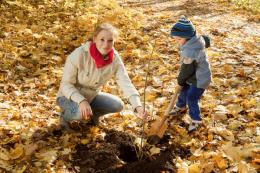Search
Login
Recommended
Planting seedlings of fruit trees. How to plant a fruit tree: pit for planting a tree, pruning a tree before planting, plant a tree correctly.
The best decoration of any suburban area is the planting of fruit trees. They delight the eye with their greenery and spring bloom, create a shadow and cool on hot days, generously bestow a rich harvest. But just to grow a garden will require a lot of time, effort, knowledge.
Content:
- Buying seedlings and planting is not such a simple matter
- Seedling structure
- Cooking the hole right
- How to get started
- How to prune a tree video
- Planting trees in autumn video
- Column-shaped seedlings of fruit trees video
Buying seedlings and planting is not such a simple matter
Let's start with the first stage - shopping. Many owners of cottages and gardens, prefer to buy seedlings of fruit trees in the markets. Sellers, as a rule, have complete information about when to plant seedlings of fruit trees and how to do it correctly.

But it happens that the seller himself is not sufficiently knowledgeable in these matters. He simply, as an employee, is hired by gardening enterprises, conducting a short educational program on this topic. In such cases, the seller communicates with the buyer, so to speak, information close to the truth. And if he messes up something or says something wrong, most likely, the planted tree will not live long or bear fruit in such volumes that it should.

Therefore, it makes sense to independently study specialized literature and obtain a certain amount of information on this topic, which would allow successful gardening.
Seedling structure
To plant a small tree correctly, you first need to know its structure. Most, even from school, know that the roots are connected to the trunk through the root neck.
Just before the landing, you need to determine exactly where this root neck begins. This can be done as follows: carefully examining the seedling, find the place where the first large root leaves.

This place will be the root of the neck.
The best seedlings of fruit trees differ:
- well developed root system
- healthy and strong look,
- trunk bark that has absolutely no defects and damages.
If the question arose where to buy seedlings of fruit trees, then if possible you should contact a specialized nursery, seedlings grown in accordance with all the rules will please you with good survival, active development, and quick start of fruiting.

When buying a seedling, you should carefully examine the roots (if the plant is not in a container, you should refuse to buy specimens with roots that have a dried appearance - there is too much risk that the plant will die. It is important that the length of the main root of the seedling exceeds thirty-five centimeters.
Cooking the hole right
Now it’s worth moving on to preparing the landing site. To do this, you will need to dig a hole, with a diameter of about 80 centimeters and a depth of 90 centimeters. After that, it must be filled with rotted manure and peat. In addition, you will need sand and complex fertilizers.

At this stage of preparing the site for landing, in the dug hole in its center, you need to drive a stake. Later, it is to him that a seedling is tied (so that the tree grows evenly). Backfill of the pit should occur in layers: soil, humus, peat, fertilizers, then again the soil and so on until it is completely filled.
The filling should be stopped only after a mound appears around the seedling (on top of the soil level), about 20 centimeters high. Over time, this elevation will offset the shrinkage of the soil.
If this is not done, then after a certain time, a depression forms around the young tree. After the first rainfall, it will be filled with water, which in turn, in most cases, leads to the beginning of the process of decay, both the root system and the bark.

Although on the other hand, the complete absence of moisture will also adversely affect the plant. To balance this balance, you need to design the so-called rim around the plant. It will contribute to the absorption of water in depth and prevent its spreading over the territory of the site.
Getting down to landing

Now you can go directly to the planting of a young tree. In the middle of the mound poured, you need to dig a recess, the size of which is slightly larger than the dimensions of the root system of the seedling.
It is necessary to place the plant in a recess so that the root neck, after powdering, remains approximately 5-6 cm above the soil. The roots themselves must be spread out as accurately and evenly as possible in width and depth. Before the first watering, the newly poured soil is compacted. Usually do this with the foot, directing the sock to the seedling.
Garter of the tree to the peg occurs with twine or rope, not tight. The rope is eight. The rope should not pull the plant tight to the peg, but only hold it in a straight upright position.

During the first watering, you need to pour about four buckets of water under the plant. Watering can be done both from a garden hose, and from a watering can. It is desirable that the water be settled and not cold (warmed up in the sun). Watering should be done slowly, allowing the water to soak up and not wash out the previously made mound.
In cases where planting was made in the spring, watering should be done every 7-10 days until the onset of autumn. If in summer the amount of precipitation is minimal, then watering should be done more often. A tree planted in autumn can be watered less often.
How to prune a seedling
Quite often it happens that the top 5-6 centimeters of a young plant planted in the fall dry out. This is due to the fact that the seedling does not have time to complete its formation before the start of preparation for wintering. Pruning of such branches can and should be done along the very border of ripened wood. The place of pruning is not at all difficult to determine.

Visually, it is very clearly visible where exactly the shoot is lignified, it differs from the immature part of the glossy bark. The unripened part is also easy to determine: on it the pubescent cortex and internodes are quite close to each other.
If there are any difficulties in determining the place of cutting, then 2-3 upper kidneys are cut. For a young, just planted plant, this will be enough. Along with this, it is worth trimming branches located on the sides. In their development, growth rate and height, they should not be ahead of the trunk in the center.

The most common death of young trees in winter occurs under the influence of many factors:
- poor resistance to climatic winter changes (quite often found in seedlings purchased not in specialized stores or outlets),
- incorrect autumn planting of fruit trees (for example, a root neck that is deeply deepened in the soil, which prevents the plant from actively and vegetatively developing, thereby hindering rapid development in a new place).
In addition to this, a too deep neck of a tree can inhibit the beginning of harvesting for a sufficiently long period. You can fix this problem as follows: dig a young plant as carefully as possible, remove a certain amount of soil, which allows you to detect the root neck.

If it turns out that it is located below the ground level, then it is worth making a deeper digging, while trying not to damage the root system and, together with the soil layer, raise it to the required height. Often, after such actions, the plant begins to bear fruit during.
We look at how to cut the seedling correctly:
Planting trees in autumn
Some recommendations point gardeners to the fact that spring planting of fruit trees is more rational. This statement is motivated by the fact that the survival rate of autumn plantings is lower, seedlings do not have the opportunity to take root before the start of winter and they die from frost. It is recommended that seedlings purchased in the fall be simply dug up, and in case of severe winters, completely covered with soil.
But, quite often, such advice is not effective. The trees seem to take root, begin to sprout new sprouts, begin to bloom, but then, the color begins to shower, and the plant itself withers.

Experienced gardeners who have tried many different methods and tips are still inclined to the idea that it is better to plant in the autumn.
It is unambiguous to say when it is better to plant trees in autumn is difficult, you should be guided by the weather and temperature conditions of the area in which the plants are planted. Roughly - September - October. At this time, the selection of seedlings is quite large. The trees planted in the fall have time to heal all the wounds inflicted during planting, with the beginning of spring they will give full development.
Details about the autumn tree planting:
Column-shaped seedlings of fruit trees
Relatively recently (1964), Canadian breeders bred the colony-like appearance of fruit trees. They can be distinguished from ordinary ones by characteristic signs:
- they completely lack lateral shoots, and on the central trunk there are many processes on which the fruits are formed;
- bark on them is much denser than on ordinary ones.

Coloniform can be not only fruit trees. They can be divided into three main types:
- coniferous - unpretentious both in terms of growth and in care, mainly used to decorate the territory in a classic style, the most famous representatives are juniper and thuja;
- deciduous - are used in the same quality as conifers, but require special care, namely, during pruning to maintain the necessary or desired shape;
- fruit - are planted not only for decoration, but also for a tasty crop.
Colon-shaped fruit plants are primarily suitable for planting in areas with small areas. Reviews of most gardeners are leaning in a positive direction. After all, a small crown allows you to plant nearby vegetables and berry bushes that will fully receive sunlight.

This type of tree is perfectly adjacent to other types of plants and at the same time decorates the site with its unusual appearance and bears fruit for everything.
About the columnar garden trees - in the video:
Seedlings are planted in the fall, clearly observing all the conditions for their planting. Only in this case, you can expect a timely and good harvest. They are planted immediately in a constant place, in rows, leaving a distance between them of about 1 meter, and between seedlings of about 40 centimeters.
After planting, the soil around the root neck is well rammed and the seedling itself is abundantly watered, about 2 buckets for each young plant.

Due to the fact that the plant abundantly bears fruit, soil depletion occurs rather quickly. Therefore, top dressing should be done regularly, but remember that everything should be in moderation. Top dressing is produced with natural fertilizers (urea or manure). It is also worth remembering about regular watering, especially in the first two years of a plant's life.
To better strengthen the root system, in the first year the fruit ovary is better to completely eliminate.





